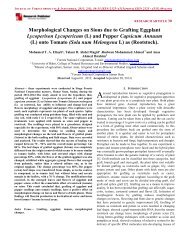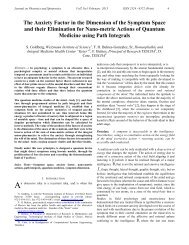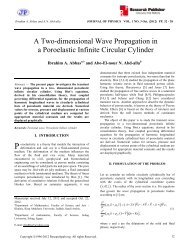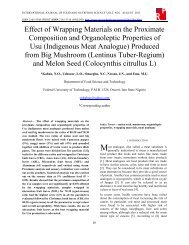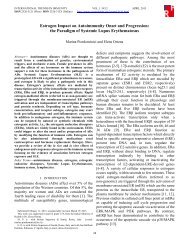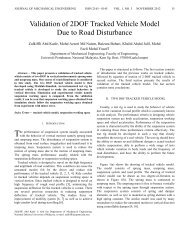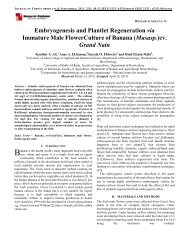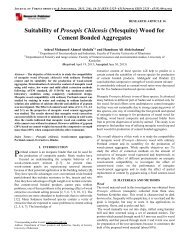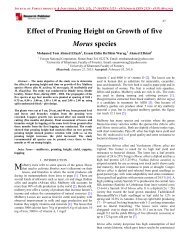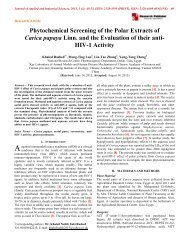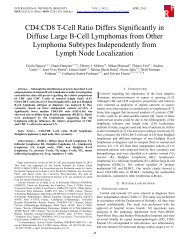Baker's Yeast Quality Evaluation for Repacking and Storage under ...
Baker's Yeast Quality Evaluation for Repacking and Storage under ...
Baker's Yeast Quality Evaluation for Repacking and Storage under ...
- No tags were found...
You also want an ePaper? Increase the reach of your titles
YUMPU automatically turns print PDFs into web optimized ePapers that Google loves.
GenusShapeSpore<strong>for</strong>mingMotilitytestO/F testCatalasetestoxidizestestGrowth inairGramstrainJournal of Applied <strong>and</strong> Industrial Sciences, 2013, 1 (2): 6-15, ISSN: 2328-4595 (PRINT), ISSN: 2328-4609 (ONLINE)Questionnaire: Results of the questionnaire made aboutBaker’s <strong>Yeast</strong> selling in Khartoum North were illustrated inTable (11) <strong>for</strong> one hundred shopkeepers.Data AnalysisResults were analyzed statistically <strong>and</strong> the analysis ofvariance was per<strong>for</strong>med (at P ≤0.05 level) to determine thedeterioration in CFU/gr, yeast activity, specific volume <strong>and</strong>sensory evaluation of yeast samples with time consumed inroom temperature <strong>and</strong> refrigerator, organoleplic test <strong>and</strong>questionnaire raw data. Examination the significant differencesusing Least Significant Difference (LSD) test to separate themeans [29].III. RESULTS AND DISCUSSIONThe yeast strains studied were coded <strong>and</strong> noted in Table (1).The rheological characteristics of wheat flour used arepresented in Table (2).Table 2.Rheological Analysis of the Wheat FlourParameterResultWater absorption (%) 64.2Dough, Stability (min) 7.2Dough, Development time (min) 5.7Water absorption of wheat flour was found 64.2% whichlies within the range of 58.6% to 65.1% of Canadian flours,<strong>and</strong> similar develop time (5.7 minutes) reported [30]. Recentknowledge about the roles of water in the manufacture of fresh<strong>and</strong> frozen yeasted dough was reviewed [10].The stability ofdough was found 7.2 minutes which found less than 17.2minutes [31]. In terms of dough strength determined byFarinograph, the flour used was generally designated as strongwheat flour. The characteristics of the flour used were ofst<strong>and</strong>ard baking quality. The results of gluten index, wet gluten<strong>and</strong> dry gluten that shown in Table (3), were 71.35%, 38.3%<strong>and</strong> 12.9% respectively. The gluten index was found lowerthan 80%, which represents the st<strong>and</strong>ard good quality breadflour [32].Table 3.Gluten Quantity <strong>and</strong> qualityParameterResultWet gluten% 38.3Dry gluten% 12.9Gluten index% 71.35The viable counts as CFU/gr of the yeast factory sealedpackages were presented in Table (4).Table 4.The Viable Counts of <strong>Yeast</strong>s A, B <strong>and</strong> C as CFU/G<strong>and</strong> the Total Bacterial Contamination of Factory SealedPackage.SampleViablecount(CFU/g)Graycolonies(count/g)Bacterial countsYellowcolonies(count/g)8Total(count/g)A 1.3 x 10 10 2.2 x 10 2 1.5 x 10 2 3.7 x 10 2B 1.1 x 10 10 3.2 x 10 3 - 3.2 X 10 3C 1.5 X 10 10 1.0 X 10 4 - 1.0 x 10 4Where: A: Saf-instant. B: Fermipan . C: MauripanThe CFU/gr <strong>for</strong> samples A, B <strong>and</strong> C, were found to be1.3X10 10 /gr, 1.1X10 10 <strong>and</strong> 1.5X10 10 gr, respectively. Onegram of baker’s yeast should contain about 3X10 10 CFU/gr[33] <strong>and</strong> [34]. This means that, the viability of samples <strong>under</strong>study was lower than the theoretical value <strong>for</strong> about onedecimal. One gram of baker’s yeast should contain not lessthan 10 billion 1X10 10 CFU/gr. [35]. Accordingly, the yeastsamples <strong>under</strong> study be<strong>for</strong>e storage can be considered as goodquality yeasts. In fact, a colony may be <strong>for</strong>med from more thanone yeast cell. It is there<strong>for</strong>e important to be careful if onewants to judge the viability of yeast from their CFU/gr, onehas to know their activity as well. The three commercialbr<strong>and</strong>s of yeast were tested <strong>for</strong> contamination with bacteria.The bacteria associated with samples were isolated accordingto their color <strong>and</strong> shape of the colonies as shown in Table (5).Actually, two different colonies were found associating withsamples. One colony group was yellowish in color while theother colony group was grayish. The yellowish coloniescontaminating baker’s yeast samples were tentativelyidentified as Bacillus spp. The gray colonies were tentativelyidentified as Staphylococcus spp. as presented in Table (5).Table 5. Isolates of Bacterial Genera Contaminating the Factory Sealed PackagesColonyYellowColonies+ve +ve -ve +ve F +ve +ve Rod BacillusGrayColonies +ve +ve -ve +ve F -ve -ve Cocci Staphylococcus



